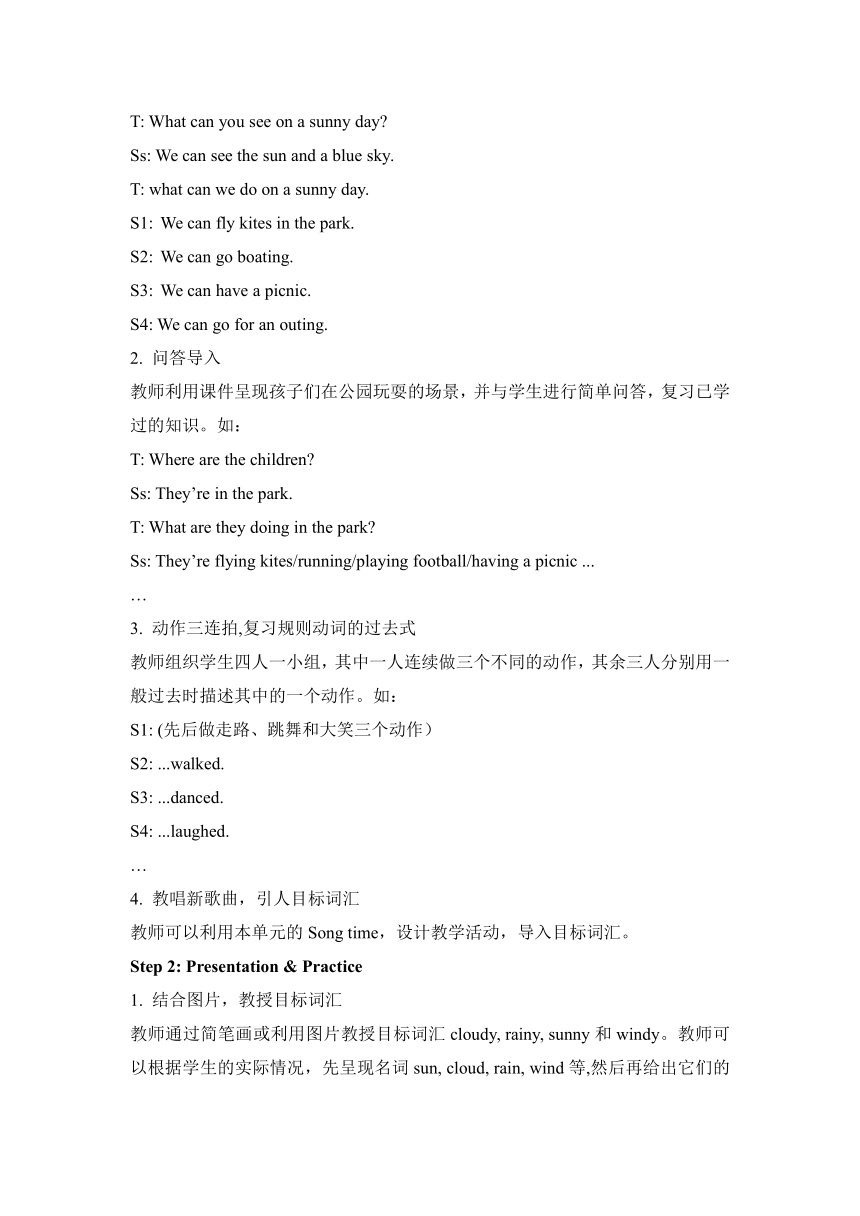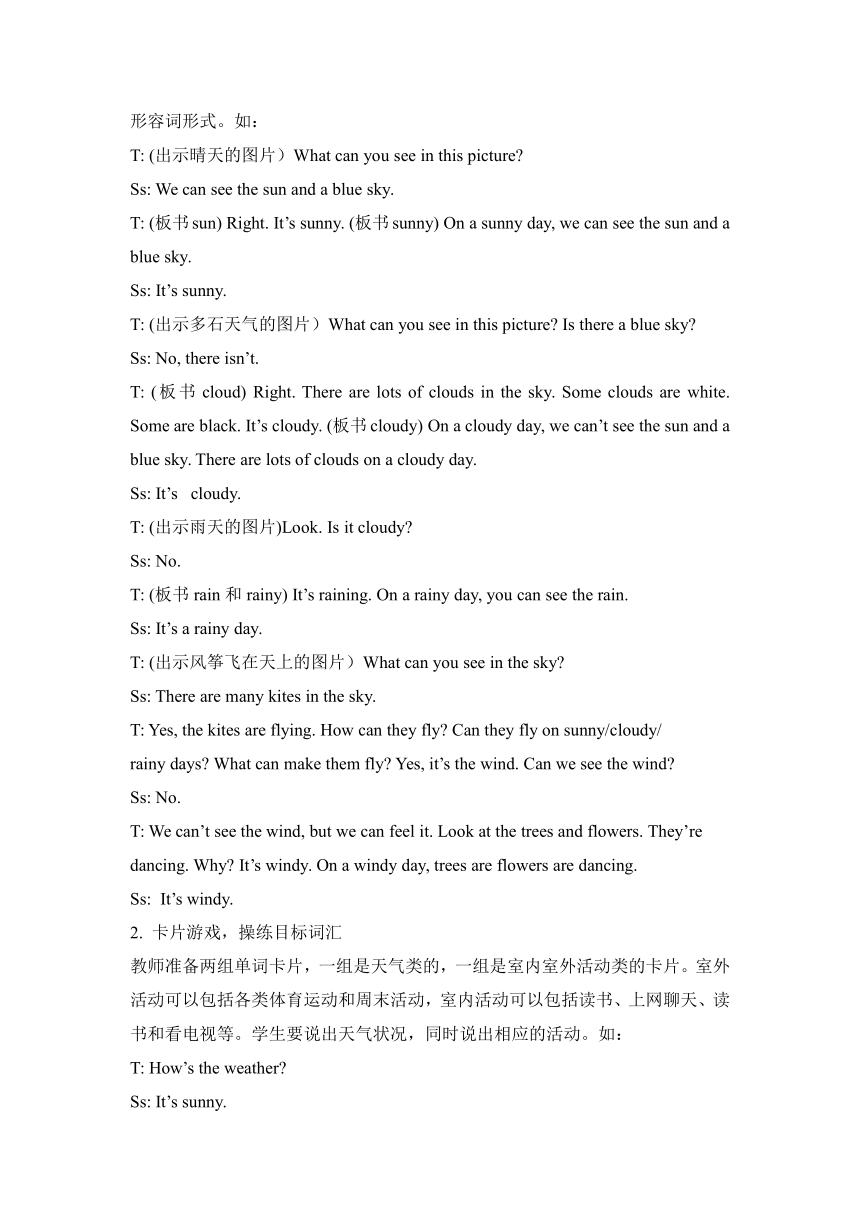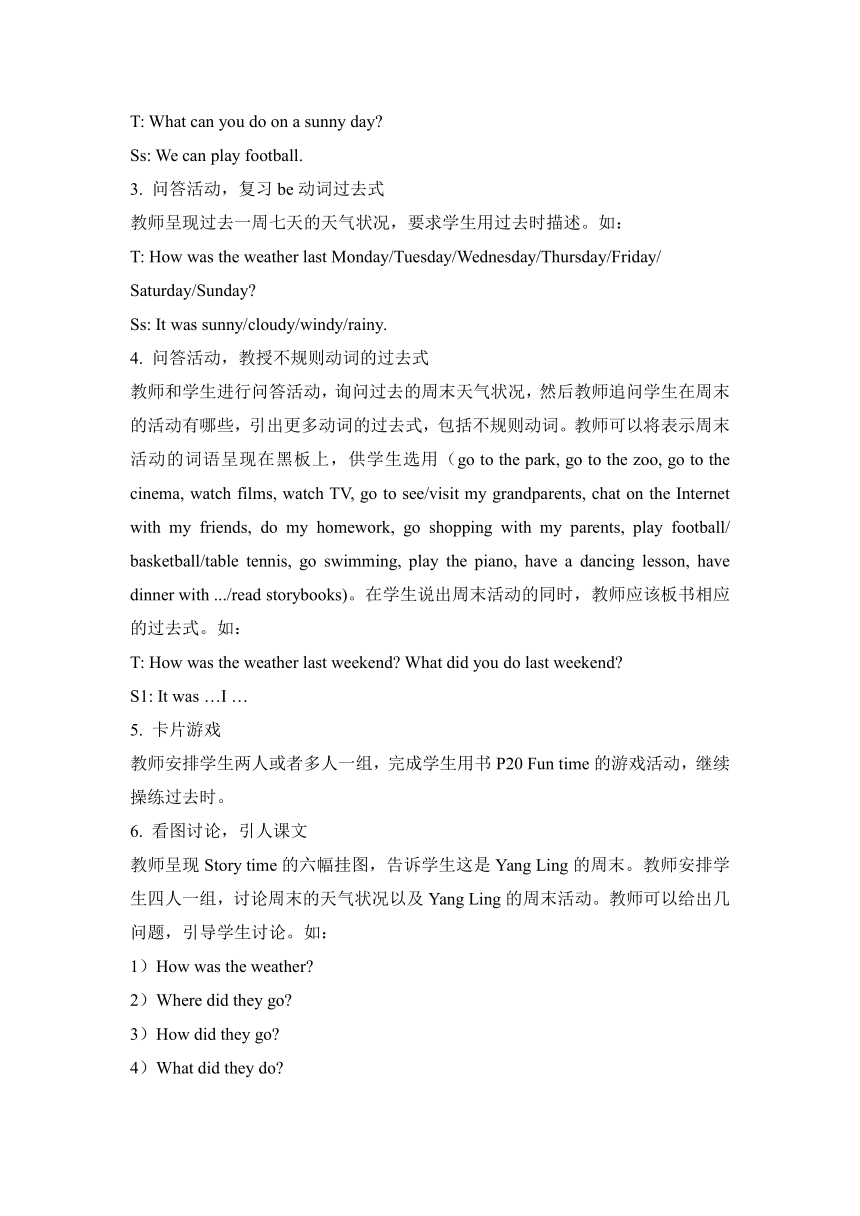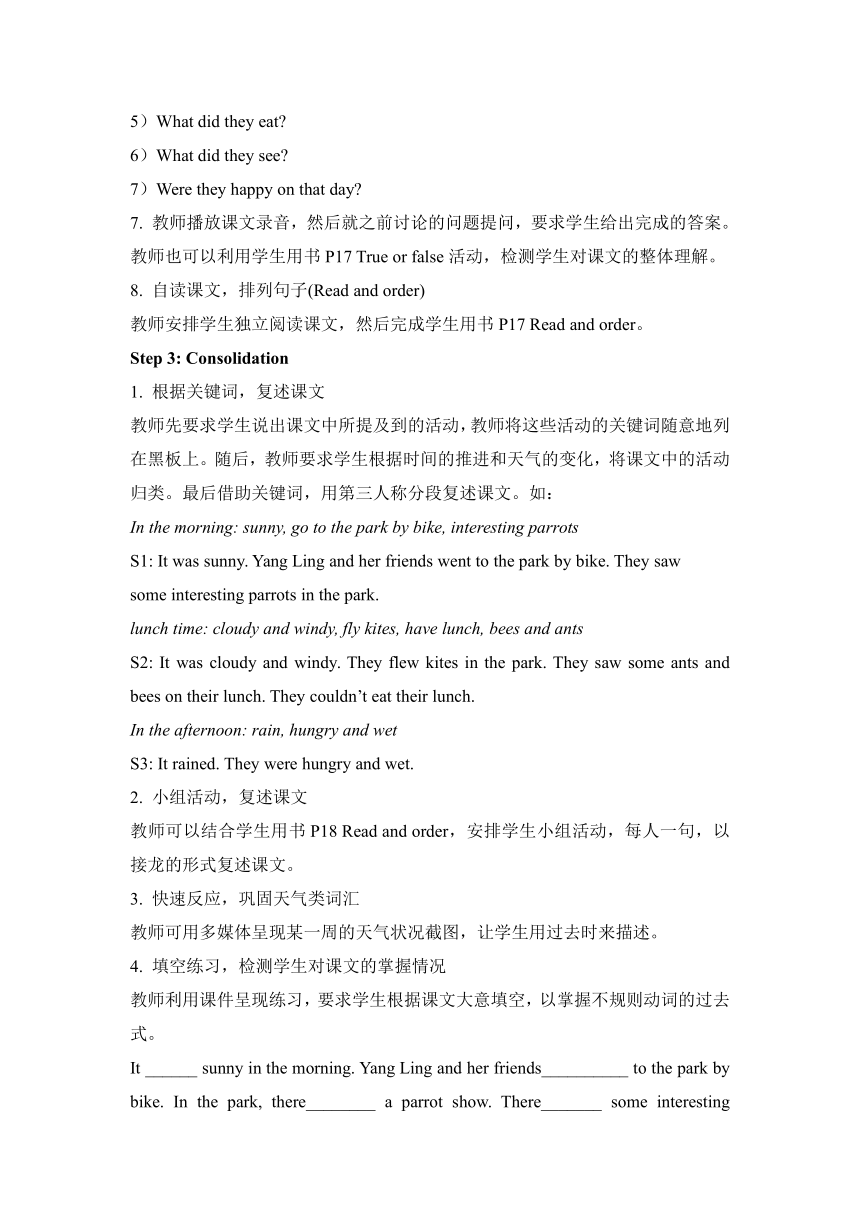Unit 2 What a day!教案 (4个课时)
文档属性
| 名称 | Unit 2 What a day!教案 (4个课时) |

|
|
| 格式 | doc | ||
| 文件大小 | 69.0KB | ||
| 资源类型 | 教案 | ||
| 版本资源 | 牛津译林版 | ||
| 科目 | 英语 | ||
| 更新时间 | 2021-06-22 14:20:59 | ||
图片预览





文档简介
Unit2 What a day!教案
第1课时
【内容来源】译林版(六年级)上册Unit2
【主 题】What a day!
【课 时】第1课时:Story time; Checkout time
一、板块介绍
本部分以日记的形式记录了Yang Ling和朋友们周末一天在公园的活动。日记通过天气的不断变换,逐步推动活动的发展和人物心理的变化。
二、教学目标
1、能听懂、会说、会读、会写cloudy, rainy, sunny, windy;
2、能听懂、会说、会读Story time中的故事,及there was/were…
3、能够熟练掌握一般过去式的用法,能用一般过去时描述刚过去的周末活动。
三、教学重难点
1、句型:It was …. /There was …. /We saw ….
2、词汇:cloudy, rainy, sunny, windy表示天气的词;以及show, interesting, weather, become, high, sky等词汇。
四、教学准备
教学课件、课文录音、动画、教材图片、天气类图片。
五、教学过程
Step 1: Warm-up/Lead-in
歌曲导人
教师可带领学生再唱四年级下册Unit 5的歌曲A sunny day,然后就歌词和学生进行简单的问答,导入目标词汇。
如:
S1: There is a man. He is short and fat.
S2: There is a man. He is tall and thin.
S3: There is a king. He is old and fat.
S4: There is a boy. He is cute and happy.
T: How’s the weather?
Ss: It’s sunny.
T: What can you see on a sunny day?
Ss: We can see the sun and a blue sky.
T: what can we do on a sunny day.
S1: We can fly kites in the park.
S2: We can go boating.
S3: We can have a picnic.
S4: We can go for an outing.
2. 问答导入
教师利用课件呈现孩子们在公园玩耍的场景,并与学生进行简单问答,复习已学
过的知识。如:
T: Where are the children?
Ss: They’re in the park.
T: What are they doing in the park?
Ss: They’re flying kites/running/playing football/having a picnic ...
…
3. 动作三连拍,复习规则动词的过去式
教师组织学生四人一小组,其中一人连续做三个不同的动作,其余三人分别用一般过去时描述其中的一个动作。如:
S1: (先后做走路、跳舞和大笑三个动作)
S2: ...walked.
S3: ...danced.
S4: ...laughed.
…
4. 教唱新歌曲,引人目标词汇
教师可以利用本单元的Song time,设计教学活动,导入目标词汇。
Step 2: Presentation & Practice
1. 结合图片,教授目标词汇
教师通过简笔画或利用图片教授目标词汇cloudy, rainy, sunny和windy。教师可以根据学生的实际情况,先呈现名词sun, cloud, rain, wind等,然后再给出它们的形容词形式。如:
T: (出示晴天的图片)What can you see in this picture?
Ss: We can see the sun and a blue sky.
T: (板书sun) Right. It’s sunny. (板书sunny) On a sunny day, we can see the sun and a blue sky.
Ss: It’s sunny.
T: (出示多石天气的图片)What can you see in this picture? Is there a blue sky?
Ss: No, there isn’t.
T: (板书cloud) Right. There are lots of clouds in the sky. Some clouds are white. Some are black. It’s cloudy. (板书cloudy) On a cloudy day, we can’t see the sun and a blue sky. There are lots of clouds on a cloudy day.
Ss: It’s cloudy.
T: (出示雨天的图片)Look. Is it cloudy?
Ss: No.
T: (板书rain和rainy) It’s raining. On a rainy day, you can see the rain.
Ss: It’s a rainy day.
T: (出示风筝飞在天上的图片)What can you see in the sky?
Ss: There are many kites in the sky.
T: Yes, the kites are flying. How can they fly? Can they fly on sunny/cloudy/
rainy days? What can make them fly? Yes, it’s the wind. Can we see the wind?
Ss: No.
T: We can’t see the wind, but we can feel it. Look at the trees and flowers. They’re
dancing. Why? It’s windy. On a windy day, trees are flowers are dancing.
Ss: It’s windy.
2. 卡片游戏,操练目标词汇
教师准备两组单词卡片,一组是天气类的,一组是室内室外活动类的卡片。室外活动可以包括各类体育运动和周末活动,室内活动可以包括读书、上网聊天、读书和看电视等。学生要说出天气状况,同时说出相应的活动。如:
T: How’s the weather?
Ss: It’s sunny.
T: What can you do on a sunny day?
Ss: We can play football.
3. 问答活动,复习be动词过去式
教师呈现过去一周七天的天气状况,要求学生用过去时描述。如:
T: How was the weather last Monday/Tuesday/Wednesday/Thursday/Friday/
Saturday/Sunday?
Ss: It was sunny/cloudy/windy/rainy.
4. 问答活动,教授不规则动词的过去式
教师和学生进行问答活动,询问过去的周末天气状况,然后教师追问学生在周末的活动有哪些,引出更多动词的过去式,包括不规则动词。教师可以将表示周末活动的词语呈现在黑板上,供学生选用(go to the park, go to the zoo, go to the cinema, watch films, watch TV, go to see/visit my grandparents, chat on the Internet with my friends, do my homework, go shopping with my parents, play football/ basketball/table tennis, go swimming, play the piano, have a dancing lesson, have dinner with .../read storybooks)。在学生说出周末活动的同时,教师应该板书相应的过去式。如:
T: How was the weather last weekend? What did you do last weekend?
S1: It was …I …
5. 卡片游戏
教师安排学生两人或者多人一组,完成学生用书P20 Fun time的游戏活动,继续操练过去时。
6. 看图讨论,引人课文
教师呈现Story time的六幅挂图,告诉学生这是Yang Ling的周末。教师安排学生四人一组,讨论周末的天气状况以及Yang Ling的周末活动。教师可以给出几问题,引导学生讨论。如:
1)How was the weather?
2)Where did they go?
3)How did they go?
4)What did they do?
5)What did they eat?
6)What did they see?
7)Were they happy on that day?
7. 教师播放课文录音,然后就之前讨论的问题提问,要求学生给出完成的答案。教师也可以利用学生用书P17 True or false活动,检测学生对课文的整体理解。
8. 自读课文,排列句子(Read and order)
教师安排学生独立阅读课文,然后完成学生用书P17 Read and order。
Step 3: Consolidation
1. 根据关键词,复述课文
教师先要求学生说出课文中所提及到的活动,教师将这些活动的关键词随意地列 在黑板上。随后,教师要求学生根据时间的推进和天气的变化,将课文中的活动归类。最后借助关键词,用第三人称分段复述课文。如:
In the morning: sunny, go to the park by bike, interesting parrots
S1: It was sunny. Yang Ling and her friends went to the park by bike. They saw
some interesting parrots in the park.
lunch time: cloudy and windy, fly kites, have lunch, bees and ants
S2: It was cloudy and windy. They flew kites in the park. They saw some ants and bees on their lunch. They couldn’t eat their lunch.
In the afternoon: rain, hungry and wet
S3: It rained. They were hungry and wet.
2. 小组活动,复述课文
教师可以结合学生用书P18 Read and order,安排学生小组活动,每人一句,以接龙的形式复述课文。
3. 快速反应,巩固天气类词汇
教师可用多媒体呈现某一周的天气状况截图,让学生用过去时来描述。
4. 填空练习,检测学生对课文的掌握情况
教师利用课件呈现练习,要求学生根据课文大意填空,以掌握不规则动词的过去
式。
It ______ sunny in the morning. Yang Ling and her friends__________ to the park by bike. In the park, there________ a parrot show. There_______ some interesting parrots. Then the weather ________ windy and cloudy. The children ________ kites. They ________ some food and drinks to the park. They did not eat their lunch, because they ________ some ants and bees on the bread and honey. In the afternoon, there________ some black clouds in the sky. It_____ They_________ hungry and wet.
5. 听力训练
教师播放录音,要求学生听一段文字,完成学生用书P24 Checkout time中的Listen and choose。
6. 说写活动
教师安排学生四人一组,进行问答活动,说一说自己在过去的周末所做的事情。在口头表达的基础上,教师再安排学生完成学生用书P25 Checkout time中的Think and write。教师可以提供更多的有关周末活动的词汇,供学生选用。
Read and order
参考答案
c, a, f, d, e,g, b
True or false
参考答案
1 F 2 T 3 T 4 T 5 T
Step 4: Summary
师生一起总结本课所学的词汇和句型,鼓励学生提出问题。教师点评学生的表现。
Step 5: Homework
用本课所学的知识写一篇小日记,记录自己上周末都做了什么活动。并注意一般过去式时态的运用。
Unit2 第2课时
【内容来源】译林版(六年级)上册Unit2
【主 题】What a day!
【课 时】第2课 Grammar time; Fun time
一、板块介绍
本板块归纳了天气的过去时表达形式和Story time中出现的不规则动词的过去式构成。
二、教学目标
1、能够掌握动词的一般过去式动词构成及其发音。
2、能天气的过去时表达形式和Story time中出现的不规则动词的过去式。
三、教学重难点
不规则动词过去式的构成及其发音
四、教学准备
教学课件、课文录音。
五、教学过程
Step 1: Warm-up/Lead-in
Listen and guess
教师可以课前准备不同天气的音效,要求学生听后说出天气状况。如:
T: (播放风声音效) How is the weather?
Ss: It’s windy.
T: (播放知了叫声音效) How is the weather?
Ss: It’s sunny and hot.
T: (播放下雨音效) How is the weather?
Ss: It’s raining.
Step 2: Presentation/Practice
1. 再读课文,圈出所有动词的过去式
教师要求学再读Story time中的课文,圈出所有动词的过去式。教师可要求学生将 这些过去式逐一列在黑板上,然后和学生一起写出它们的动词原形。
2. 游戏竞赛,巩固不规则动词的过去式
教师将学生分成两组,然后出示一个不规则动词的原形,要求学生给出过去式。教师可以根据学生的具体情况,要求学生在给出过去式后再造句。如:
T: Bring.
S1: Brought. I brought an apple to school today.
3. 设计练习,操练规则动词和不规则动词的过去式
教师可以设计句子,要求学生用所给动词的正确形式填空。教师可以综合第一单 元的规则动词和be动词的过去式,检测学生对一般过去时的掌握情况。
例如:It ____ (be ) sunny last Sunday.
It ____ (be ) windy the day before yesterday.
We ____ (see ) many interesting movie.
He ____ (bring) many beautiful flower for her friends..
….
Step 3: Consolidation
Fun time
本部分是一个“翻翻乐”的卡片游戏,要求学生在三组卡片中分别取出一张,并根据卡片后面的内容,用过去时描述天气和活动。教师可安排学生在课前准备更多的有关周末活动和场景的卡片,使操练活动更加丰富、有趣。
1. 看图问答
教师出示所有图片,然后用现在时和学生进行问答活动,引导学生理解图意。如:
T: How’s the weather?
Ss: It’s sunny.
T: What’s this?
Ss: It’s a bedroom.
T: What’s he/she doing?
Ss: He’s/She’s flying a kite/watching TV/playing football.
2. 示范游戏
教师利用课件将本部分的所有图片遮住并依次标上数字,随后邀请一名学生从每 一排中任选一个数字,教师出示对应图片,其余学生根据图片信息,用过去时做出描述。如:
A1 A2 A3 A4
B1 B2 B3 B4
Cl C2 C3 C4
T: Please pick three cards.
S1: A4, B1 and C3.
Ss: It was a rainy day. I played basketball in the park.
3. 小组竞赛
教师将学生成四大组,教师任意选取三张卡片,然后要求学生说出包括天气、地 点、活动的两句话。最先表达的小组获胜。
Step 4: Summary
师生一起总结本课所学的动词的过去式及不规则动词的过去式和发音,鼓励学生提出问题。教师点评学生的表现。
Step 5: Homework
请写出下列单词的过去式:bring, become, can, take, see, saw, fly.
Unit2 第3课时
【内容来源】译林版(六年级)上册Unit2
【主 题】What a day!
【课 时】第3课 Sound time; Song time
一、板块介绍
本板块呈现了字母组合ear在单词中的读音,即/i?/。
二、教学目标
1、能够掌握单词字母组合ear在单词中的读音。
2、能正确朗读课文Sound time。
三、教学重难点
能够掌握字母组合ear在单词中不同的发音规则。
四、教学准备
教学课件、课文录音、教材动画。
五、教学过程
Step 1: Warm-up/Lead-in
Song time
这是一首充满童趣的歌曲。小男孩Johnny因为下雨无法到户外玩耍,便祈祷雨能快快停止,改天再下雨。(这首歌曲的歌词节奏感强,教师可要求学生将其当作歌瑶反复唱诵或背诵。)
1. 呈现图片,引入歌曲
教师呈现图片,和学生进行简单的问答活动,引入歌曲。如:
T: Who’s the boy?
Ss: He’s Johnny.
T: How’s the weather?
Ss: It’s raining.
T: Does Johnny look happy?
Ss: No. He looks sad.
2. 唱诵歌词
教师和学生一起有节奏地朗读歌词。教师可与学生以Making a wish的方式唱诵歌词,并通过唱诵的速度快慢传达愿望的强弱。如:
T: If the rain goes away, it would be a nice day. Everyone would be happy. Let’s make a wish.
Rain, rain, go away.
Come again another day.
…
3. 播放录音,跟唱歌曲。
教师播放歌曲录音,让学生跟唱。教师也可以安排学生小组唱、男女生分组唱或齐唱等活动。
Step 2: Presentation/Practice
教师PPT先出示单词dear, hear, near, year等含有字母组合是ear的单词。让学生看以上单词并尝试跟读出来。教师并提出问题让学生思考这些字母组合的发音有什么不同。
示范朗读
教师示范朗读单词,也可请发音较好的学生做示范。教师要提醒学生边听边体会, 找出各单词共同的读音/i?/。
3. 跟读录音
教师播放录音,要求学生跟读单词和绕口令。
4. 发现规律
在朗读过程中,教师可以引导学生发现绕口令中here和cheer也含有音素如/i?/。
5. 游戏竞赛
教师可组织学生开展绕口令朗读比赛,或拍手游戏,即读到含有/i?/读音的单词就拍手,看谁读得既准确又有节奏感。
6. 运用规则
教师鼓励学生认读生词tear, gear, fear, clear, beer等。
Step 3: Consolidation
单词闪卡
教师将学生分成若干组,并在PPT上展示含有字母组合ear的单词。让学生看见教师出示的单词图片,立刻读出该单词的发音。教师并评选出表现优异的小组成员,并鼓励学生大胆积极说出单词的读音。
2. 小组竞赛
教师将学生分成四大组,让学生朗读以下句子。教师并评选出最佳好声音奖,并奖励给获奖小组成员。
Step 4: Summary
师生一起总结本课所学的含有ear组合的单词发音规则。并让学生正确读出该单词的正确发音。
Step 5: Homework
学唱歌曲:Rain, rain, go away.
Unit2 第4课时
【内容来源】译林版(六年级)上册Unit2
【主 题】What a day!
【课 时】第4课 Cartoon time
一、板块介绍
本板块讲述的是Sam在公园里遇到Bobby,发现他不太开心,便问他发生了什么事,原来Bobby放风筝的时候不小心把风筝弄丢了。这时,Sam从背后拿出一个风筝,问是不是Bobby的。Bobby喜出望外,原来Sam捡到的正是Bobby弄丟的风筝。
二、教学目标
1、能够总结出动词的一般过去式。
2、能正确朗读课文Cartoon time, 并学会复述课文故事。
三、教学重难点
能够熟练运用动词的一般过去式并正确复述课文故事。
四、教学准备
教学课件、课文录音、教材动画。
五、教学过程
Step 1: Warm-up/Lead-in
Sing a song
教师播放Song time录音,并让学生跟唱歌曲。教师也可以安排学生小组唱、男女生分组唱或齐唱等活动。活跃课堂气氛,提高学生学习兴趣。
Step 2: Presentation/Practice
1. 图片导入,启发思考
教师出示四幅图片,和学生进行问答活动,引导学生预测故事情节。如:
1)What’s the matter with Bobby?
2)What are Sam and Bobby talking about?
3)Where did Bobby and Tina fly the kite first?
4)Where did Bobby and Tina fly the kite then?
5)What happened finally?
2. 播放动画或录音,理解故事
教师播放动画或录音,要求学生继续思考之前提出的问题,理解故事的大意。
3. 复述故事
教师要求学生根据图片和关键词,复述Bobby放风筝的遭遇。教师可以安排学生小组活动,每人一句,接龙复述故事。如:
S1: Bobby had a new kite.
S2: One day, Bobby and Tina flew the kite in the park.
S3: It wasn’t windy in the park.
S4: They climbed up the hill.
S1: They flew the kite on the hill.
S2: It was very windy there.
S3: The kite flew high.
S4: Bobby couldn’t hold onto the kite.
S1: The kite flew away.
S2: Bobby was very sad.
Step 3: Consolidation
归纳动词的过去式
教师要求学生再读故事,并圈出动词的过去式。教师和学生一起给出这些过去式的动词原形。如:
happened → happen lost → lose
climbed → climb could → can
found → find flew → fly
2. 角色扮演竞赛
教师将学生分成四大组,请学生分角色表演课文Cartoon time。教师并根据学生的表现评选出我是小小表演家。
Step 4: Summary
师生一起总结Cartoon time中单词的过去式,教师和学生一起复述课文故事。
Step 5: Homework
学生2-3人一组,分角色朗读并表演Cartoon time. 可在此基础上加以故事创编。
第1课时
【内容来源】译林版(六年级)上册Unit2
【主 题】What a day!
【课 时】第1课时:Story time; Checkout time
一、板块介绍
本部分以日记的形式记录了Yang Ling和朋友们周末一天在公园的活动。日记通过天气的不断变换,逐步推动活动的发展和人物心理的变化。
二、教学目标
1、能听懂、会说、会读、会写cloudy, rainy, sunny, windy;
2、能听懂、会说、会读Story time中的故事,及there was/were…
3、能够熟练掌握一般过去式的用法,能用一般过去时描述刚过去的周末活动。
三、教学重难点
1、句型:It was …. /There was …. /We saw ….
2、词汇:cloudy, rainy, sunny, windy表示天气的词;以及show, interesting, weather, become, high, sky等词汇。
四、教学准备
教学课件、课文录音、动画、教材图片、天气类图片。
五、教学过程
Step 1: Warm-up/Lead-in
歌曲导人
教师可带领学生再唱四年级下册Unit 5的歌曲A sunny day,然后就歌词和学生进行简单的问答,导入目标词汇。
如:
S1: There is a man. He is short and fat.
S2: There is a man. He is tall and thin.
S3: There is a king. He is old and fat.
S4: There is a boy. He is cute and happy.
T: How’s the weather?
Ss: It’s sunny.
T: What can you see on a sunny day?
Ss: We can see the sun and a blue sky.
T: what can we do on a sunny day.
S1: We can fly kites in the park.
S2: We can go boating.
S3: We can have a picnic.
S4: We can go for an outing.
2. 问答导入
教师利用课件呈现孩子们在公园玩耍的场景,并与学生进行简单问答,复习已学
过的知识。如:
T: Where are the children?
Ss: They’re in the park.
T: What are they doing in the park?
Ss: They’re flying kites/running/playing football/having a picnic ...
…
3. 动作三连拍,复习规则动词的过去式
教师组织学生四人一小组,其中一人连续做三个不同的动作,其余三人分别用一般过去时描述其中的一个动作。如:
S1: (先后做走路、跳舞和大笑三个动作)
S2: ...walked.
S3: ...danced.
S4: ...laughed.
…
4. 教唱新歌曲,引人目标词汇
教师可以利用本单元的Song time,设计教学活动,导入目标词汇。
Step 2: Presentation & Practice
1. 结合图片,教授目标词汇
教师通过简笔画或利用图片教授目标词汇cloudy, rainy, sunny和windy。教师可以根据学生的实际情况,先呈现名词sun, cloud, rain, wind等,然后再给出它们的形容词形式。如:
T: (出示晴天的图片)What can you see in this picture?
Ss: We can see the sun and a blue sky.
T: (板书sun) Right. It’s sunny. (板书sunny) On a sunny day, we can see the sun and a blue sky.
Ss: It’s sunny.
T: (出示多石天气的图片)What can you see in this picture? Is there a blue sky?
Ss: No, there isn’t.
T: (板书cloud) Right. There are lots of clouds in the sky. Some clouds are white. Some are black. It’s cloudy. (板书cloudy) On a cloudy day, we can’t see the sun and a blue sky. There are lots of clouds on a cloudy day.
Ss: It’s cloudy.
T: (出示雨天的图片)Look. Is it cloudy?
Ss: No.
T: (板书rain和rainy) It’s raining. On a rainy day, you can see the rain.
Ss: It’s a rainy day.
T: (出示风筝飞在天上的图片)What can you see in the sky?
Ss: There are many kites in the sky.
T: Yes, the kites are flying. How can they fly? Can they fly on sunny/cloudy/
rainy days? What can make them fly? Yes, it’s the wind. Can we see the wind?
Ss: No.
T: We can’t see the wind, but we can feel it. Look at the trees and flowers. They’re
dancing. Why? It’s windy. On a windy day, trees are flowers are dancing.
Ss: It’s windy.
2. 卡片游戏,操练目标词汇
教师准备两组单词卡片,一组是天气类的,一组是室内室外活动类的卡片。室外活动可以包括各类体育运动和周末活动,室内活动可以包括读书、上网聊天、读书和看电视等。学生要说出天气状况,同时说出相应的活动。如:
T: How’s the weather?
Ss: It’s sunny.
T: What can you do on a sunny day?
Ss: We can play football.
3. 问答活动,复习be动词过去式
教师呈现过去一周七天的天气状况,要求学生用过去时描述。如:
T: How was the weather last Monday/Tuesday/Wednesday/Thursday/Friday/
Saturday/Sunday?
Ss: It was sunny/cloudy/windy/rainy.
4. 问答活动,教授不规则动词的过去式
教师和学生进行问答活动,询问过去的周末天气状况,然后教师追问学生在周末的活动有哪些,引出更多动词的过去式,包括不规则动词。教师可以将表示周末活动的词语呈现在黑板上,供学生选用(go to the park, go to the zoo, go to the cinema, watch films, watch TV, go to see/visit my grandparents, chat on the Internet with my friends, do my homework, go shopping with my parents, play football/ basketball/table tennis, go swimming, play the piano, have a dancing lesson, have dinner with .../read storybooks)。在学生说出周末活动的同时,教师应该板书相应的过去式。如:
T: How was the weather last weekend? What did you do last weekend?
S1: It was …I …
5. 卡片游戏
教师安排学生两人或者多人一组,完成学生用书P20 Fun time的游戏活动,继续操练过去时。
6. 看图讨论,引人课文
教师呈现Story time的六幅挂图,告诉学生这是Yang Ling的周末。教师安排学生四人一组,讨论周末的天气状况以及Yang Ling的周末活动。教师可以给出几问题,引导学生讨论。如:
1)How was the weather?
2)Where did they go?
3)How did they go?
4)What did they do?
5)What did they eat?
6)What did they see?
7)Were they happy on that day?
7. 教师播放课文录音,然后就之前讨论的问题提问,要求学生给出完成的答案。教师也可以利用学生用书P17 True or false活动,检测学生对课文的整体理解。
8. 自读课文,排列句子(Read and order)
教师安排学生独立阅读课文,然后完成学生用书P17 Read and order。
Step 3: Consolidation
1. 根据关键词,复述课文
教师先要求学生说出课文中所提及到的活动,教师将这些活动的关键词随意地列 在黑板上。随后,教师要求学生根据时间的推进和天气的变化,将课文中的活动归类。最后借助关键词,用第三人称分段复述课文。如:
In the morning: sunny, go to the park by bike, interesting parrots
S1: It was sunny. Yang Ling and her friends went to the park by bike. They saw
some interesting parrots in the park.
lunch time: cloudy and windy, fly kites, have lunch, bees and ants
S2: It was cloudy and windy. They flew kites in the park. They saw some ants and bees on their lunch. They couldn’t eat their lunch.
In the afternoon: rain, hungry and wet
S3: It rained. They were hungry and wet.
2. 小组活动,复述课文
教师可以结合学生用书P18 Read and order,安排学生小组活动,每人一句,以接龙的形式复述课文。
3. 快速反应,巩固天气类词汇
教师可用多媒体呈现某一周的天气状况截图,让学生用过去时来描述。
4. 填空练习,检测学生对课文的掌握情况
教师利用课件呈现练习,要求学生根据课文大意填空,以掌握不规则动词的过去
式。
It ______ sunny in the morning. Yang Ling and her friends__________ to the park by bike. In the park, there________ a parrot show. There_______ some interesting parrots. Then the weather ________ windy and cloudy. The children ________ kites. They ________ some food and drinks to the park. They did not eat their lunch, because they ________ some ants and bees on the bread and honey. In the afternoon, there________ some black clouds in the sky. It_____ They_________ hungry and wet.
5. 听力训练
教师播放录音,要求学生听一段文字,完成学生用书P24 Checkout time中的Listen and choose。
6. 说写活动
教师安排学生四人一组,进行问答活动,说一说自己在过去的周末所做的事情。在口头表达的基础上,教师再安排学生完成学生用书P25 Checkout time中的Think and write。教师可以提供更多的有关周末活动的词汇,供学生选用。
Read and order
参考答案
c, a, f, d, e,g, b
True or false
参考答案
1 F 2 T 3 T 4 T 5 T
Step 4: Summary
师生一起总结本课所学的词汇和句型,鼓励学生提出问题。教师点评学生的表现。
Step 5: Homework
用本课所学的知识写一篇小日记,记录自己上周末都做了什么活动。并注意一般过去式时态的运用。
Unit2 第2课时
【内容来源】译林版(六年级)上册Unit2
【主 题】What a day!
【课 时】第2课 Grammar time; Fun time
一、板块介绍
本板块归纳了天气的过去时表达形式和Story time中出现的不规则动词的过去式构成。
二、教学目标
1、能够掌握动词的一般过去式动词构成及其发音。
2、能天气的过去时表达形式和Story time中出现的不规则动词的过去式。
三、教学重难点
不规则动词过去式的构成及其发音
四、教学准备
教学课件、课文录音。
五、教学过程
Step 1: Warm-up/Lead-in
Listen and guess
教师可以课前准备不同天气的音效,要求学生听后说出天气状况。如:
T: (播放风声音效) How is the weather?
Ss: It’s windy.
T: (播放知了叫声音效) How is the weather?
Ss: It’s sunny and hot.
T: (播放下雨音效) How is the weather?
Ss: It’s raining.
Step 2: Presentation/Practice
1. 再读课文,圈出所有动词的过去式
教师要求学再读Story time中的课文,圈出所有动词的过去式。教师可要求学生将 这些过去式逐一列在黑板上,然后和学生一起写出它们的动词原形。
2. 游戏竞赛,巩固不规则动词的过去式
教师将学生分成两组,然后出示一个不规则动词的原形,要求学生给出过去式。教师可以根据学生的具体情况,要求学生在给出过去式后再造句。如:
T: Bring.
S1: Brought. I brought an apple to school today.
3. 设计练习,操练规则动词和不规则动词的过去式
教师可以设计句子,要求学生用所给动词的正确形式填空。教师可以综合第一单 元的规则动词和be动词的过去式,检测学生对一般过去时的掌握情况。
例如:It ____ (be ) sunny last Sunday.
It ____ (be ) windy the day before yesterday.
We ____ (see ) many interesting movie.
He ____ (bring) many beautiful flower for her friends..
….
Step 3: Consolidation
Fun time
本部分是一个“翻翻乐”的卡片游戏,要求学生在三组卡片中分别取出一张,并根据卡片后面的内容,用过去时描述天气和活动。教师可安排学生在课前准备更多的有关周末活动和场景的卡片,使操练活动更加丰富、有趣。
1. 看图问答
教师出示所有图片,然后用现在时和学生进行问答活动,引导学生理解图意。如:
T: How’s the weather?
Ss: It’s sunny.
T: What’s this?
Ss: It’s a bedroom.
T: What’s he/she doing?
Ss: He’s/She’s flying a kite/watching TV/playing football.
2. 示范游戏
教师利用课件将本部分的所有图片遮住并依次标上数字,随后邀请一名学生从每 一排中任选一个数字,教师出示对应图片,其余学生根据图片信息,用过去时做出描述。如:
A1 A2 A3 A4
B1 B2 B3 B4
Cl C2 C3 C4
T: Please pick three cards.
S1: A4, B1 and C3.
Ss: It was a rainy day. I played basketball in the park.
3. 小组竞赛
教师将学生成四大组,教师任意选取三张卡片,然后要求学生说出包括天气、地 点、活动的两句话。最先表达的小组获胜。
Step 4: Summary
师生一起总结本课所学的动词的过去式及不规则动词的过去式和发音,鼓励学生提出问题。教师点评学生的表现。
Step 5: Homework
请写出下列单词的过去式:bring, become, can, take, see, saw, fly.
Unit2 第3课时
【内容来源】译林版(六年级)上册Unit2
【主 题】What a day!
【课 时】第3课 Sound time; Song time
一、板块介绍
本板块呈现了字母组合ear在单词中的读音,即/i?/。
二、教学目标
1、能够掌握单词字母组合ear在单词中的读音。
2、能正确朗读课文Sound time。
三、教学重难点
能够掌握字母组合ear在单词中不同的发音规则。
四、教学准备
教学课件、课文录音、教材动画。
五、教学过程
Step 1: Warm-up/Lead-in
Song time
这是一首充满童趣的歌曲。小男孩Johnny因为下雨无法到户外玩耍,便祈祷雨能快快停止,改天再下雨。(这首歌曲的歌词节奏感强,教师可要求学生将其当作歌瑶反复唱诵或背诵。)
1. 呈现图片,引入歌曲
教师呈现图片,和学生进行简单的问答活动,引入歌曲。如:
T: Who’s the boy?
Ss: He’s Johnny.
T: How’s the weather?
Ss: It’s raining.
T: Does Johnny look happy?
Ss: No. He looks sad.
2. 唱诵歌词
教师和学生一起有节奏地朗读歌词。教师可与学生以Making a wish的方式唱诵歌词,并通过唱诵的速度快慢传达愿望的强弱。如:
T: If the rain goes away, it would be a nice day. Everyone would be happy. Let’s make a wish.
Rain, rain, go away.
Come again another day.
…
3. 播放录音,跟唱歌曲。
教师播放歌曲录音,让学生跟唱。教师也可以安排学生小组唱、男女生分组唱或齐唱等活动。
Step 2: Presentation/Practice
教师PPT先出示单词dear, hear, near, year等含有字母组合是ear的单词。让学生看以上单词并尝试跟读出来。教师并提出问题让学生思考这些字母组合的发音有什么不同。
示范朗读
教师示范朗读单词,也可请发音较好的学生做示范。教师要提醒学生边听边体会, 找出各单词共同的读音/i?/。
3. 跟读录音
教师播放录音,要求学生跟读单词和绕口令。
4. 发现规律
在朗读过程中,教师可以引导学生发现绕口令中here和cheer也含有音素如/i?/。
5. 游戏竞赛
教师可组织学生开展绕口令朗读比赛,或拍手游戏,即读到含有/i?/读音的单词就拍手,看谁读得既准确又有节奏感。
6. 运用规则
教师鼓励学生认读生词tear, gear, fear, clear, beer等。
Step 3: Consolidation
单词闪卡
教师将学生分成若干组,并在PPT上展示含有字母组合ear的单词。让学生看见教师出示的单词图片,立刻读出该单词的发音。教师并评选出表现优异的小组成员,并鼓励学生大胆积极说出单词的读音。
2. 小组竞赛
教师将学生分成四大组,让学生朗读以下句子。教师并评选出最佳好声音奖,并奖励给获奖小组成员。
Step 4: Summary
师生一起总结本课所学的含有ear组合的单词发音规则。并让学生正确读出该单词的正确发音。
Step 5: Homework
学唱歌曲:Rain, rain, go away.
Unit2 第4课时
【内容来源】译林版(六年级)上册Unit2
【主 题】What a day!
【课 时】第4课 Cartoon time
一、板块介绍
本板块讲述的是Sam在公园里遇到Bobby,发现他不太开心,便问他发生了什么事,原来Bobby放风筝的时候不小心把风筝弄丢了。这时,Sam从背后拿出一个风筝,问是不是Bobby的。Bobby喜出望外,原来Sam捡到的正是Bobby弄丟的风筝。
二、教学目标
1、能够总结出动词的一般过去式。
2、能正确朗读课文Cartoon time, 并学会复述课文故事。
三、教学重难点
能够熟练运用动词的一般过去式并正确复述课文故事。
四、教学准备
教学课件、课文录音、教材动画。
五、教学过程
Step 1: Warm-up/Lead-in
Sing a song
教师播放Song time录音,并让学生跟唱歌曲。教师也可以安排学生小组唱、男女生分组唱或齐唱等活动。活跃课堂气氛,提高学生学习兴趣。
Step 2: Presentation/Practice
1. 图片导入,启发思考
教师出示四幅图片,和学生进行问答活动,引导学生预测故事情节。如:
1)What’s the matter with Bobby?
2)What are Sam and Bobby talking about?
3)Where did Bobby and Tina fly the kite first?
4)Where did Bobby and Tina fly the kite then?
5)What happened finally?
2. 播放动画或录音,理解故事
教师播放动画或录音,要求学生继续思考之前提出的问题,理解故事的大意。
3. 复述故事
教师要求学生根据图片和关键词,复述Bobby放风筝的遭遇。教师可以安排学生小组活动,每人一句,接龙复述故事。如:
S1: Bobby had a new kite.
S2: One day, Bobby and Tina flew the kite in the park.
S3: It wasn’t windy in the park.
S4: They climbed up the hill.
S1: They flew the kite on the hill.
S2: It was very windy there.
S3: The kite flew high.
S4: Bobby couldn’t hold onto the kite.
S1: The kite flew away.
S2: Bobby was very sad.
Step 3: Consolidation
归纳动词的过去式
教师要求学生再读故事,并圈出动词的过去式。教师和学生一起给出这些过去式的动词原形。如:
happened → happen lost → lose
climbed → climb could → can
found → find flew → fly
2. 角色扮演竞赛
教师将学生分成四大组,请学生分角色表演课文Cartoon time。教师并根据学生的表现评选出我是小小表演家。
Step 4: Summary
师生一起总结Cartoon time中单词的过去式,教师和学生一起复述课文故事。
Step 5: Homework
学生2-3人一组,分角色朗读并表演Cartoon time. 可在此基础上加以故事创编。
